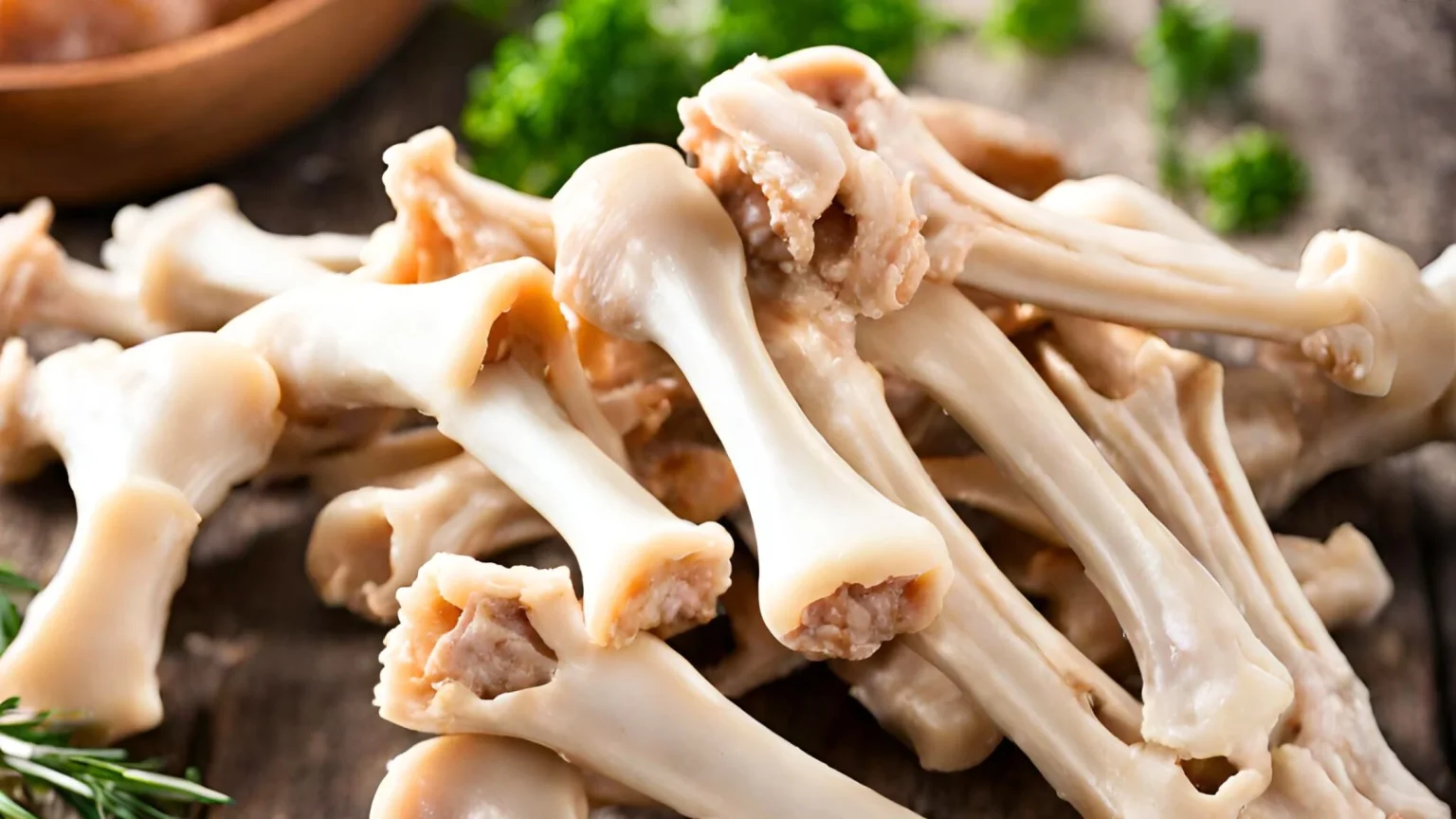When it comes to chicken, you may find yourself wondering if it’s safe and healthy to eat the bones. After all, they say waste not, want not, right? In this article, we will explore the topic of eating chicken bones and whether it is a healthy choice for you. We will delve into the nutritional value and safety considerations of consuming chicken bones.
Key Takeaways:
- Eating chicken bones may have nutritional benefits
- Proper cooking is important to ensure safety
- Consuming raw chicken bones can be risky
- Bone broth is a great way to extract nutrients from chicken bones
- There are various culinary methods to incorporate chicken bones into your diet
The Nutritional Value of Chicken Bones
When it comes to nutrition, chicken bones have more to offer than meets the eye. These seemingly insignificant scraps are packed with essential nutrients that can significantly contribute to your overall health and well-being.
One of the key nutrients found in chicken bones is calcium. As we all know, calcium plays a vital role in maintaining strong bones and teeth. By including chicken bones in your diet, you can naturally boost your calcium intake, which is particularly beneficial for individuals at risk of osteoporosis or other bone-related conditions.
Collagen, another valuable component of chicken bones, has gained popularity for its potential to improve skin elasticity and joint health. This protein is known to support the structure and integrity of our skin, tendons, ligaments, and bones, making it a sought-after nutrient in the beauty and wellness industries.
Additionally, chicken bones harbor a rich source of marrow, which is a valuable source of nutrients such as healthy fats, vitamins, and minerals. The marrow, found in the center of bones, is generously adorned with essential nutrients like phosphorus, magnesium, and potassium, which play critical roles in various bodily functions.
Moreover, chicken bones are a natural source of vitamins, including vitamin A, vitamin D, and several B vitamins. These vitamins are known for their roles in supporting immune function, promoting healthy vision, boosting energy levels, and contributing to the overall well-being of the body.
By incorporating chicken bones into your diet, you can gain access to a multitude of nutrients such as calcium, collagen, marrow, minerals, and vitamins, which can enhance your health and wellness.
Chicken Bones Nutritional Profile:
| Nutrient | Amount per 100g |
|---|---|
| Calcium | 10mg |
| Collagen | 2g |
| Marrow | 5g |
| Phosphorus | 20mg |
| Magnesium | 5mg |
| Potassium | 15mg |
| Vitamin A | 25IU |
| Vitamin D | 0.1IU |
| Vitamin B12 | 0.1mcg |
It’s evident that chicken bones are more than just mere waste. Including them in your diet can provide you with a treasure trove of essential nutrients that can support your overall well-being.
Safety Considerations and Risks of Eating Chicken Bones
When it comes to eating chicken bones, it’s important to be aware of the safety considerations and potential risks involved. While chicken bones can be a flavorful addition to your meal, there are certain precautions you should take to ensure your well-being.
Properly Cook Bone-In Cuts of Meat: Before consuming bone-in cuts of meat, it is essential to cook them thoroughly. Cooking bone-in cuts of meat at the appropriate temperature helps soften the bones, making them less likely to splinter and cause harm. By ensuring the bones are properly cooked, you can minimize the risk of any accidents.
Avoid Consuming Raw Bones: Raw bones, such as those found in uncooked chicken, pose a greater risk to your safety. Raw bones can be harder and more prone to splintering, which increases the chances of injury. It is best to avoid consuming raw bones altogether to protect yourself from any potential harm.
Risks of Bone Ingestion and Choking: One of the main concerns with eating chicken bones is the risk of bone ingestion and choking. It is crucial to be mindful while consuming bone-in cuts of meat and ensure you chew thoroughly. Ingesting larger pieces of bone can lead to discomfort or potential blockage in your digestive tract, while smaller bone fragments can pose a choking hazard.
If you experience any symptoms of bone ingestion or choking, such as difficulty swallowing or severe abdominal pain, it is essential to seek immediate medical attention. Medical professionals can evaluate your condition and provide the necessary treatment to prevent any complications.
| Risks of Eating Chicken Bones | Precautions to Take |
|---|---|
| Potential bone ingestion | Chew thoroughly and avoid ingesting large bone pieces |
| Choking hazard | Be cautious while consuming bone-in cuts of meat |
| Possible blockage in digestive tract | Seek medical attention if you experience discomfort or pain |
The Benefits of Making Chicken Bone Broth
Making chicken bone broth not only allows you to utilize the entire chicken, but it also provides numerous health benefits. This nourishing and flavorful broth is packed with essential nutrients and minerals, making it a nutritious addition to your diet.
Extracting Nutrients and Minerals
When you simmer chicken bones over a prolonged period, they release gelatin, glycine, and an array of vital nutrients and minerals. Gelatin is rich in collagen, which promotes healthy skin, hair, and nails. Additionally, gelatin also contributes to joint health and aids in digestion.
“Bone broth is a great source of glycine, an amino acid that supports the health of your gut lining. It helps with nutrient absorption and reduces inflammation in the digestive tract.” – Dr. Jane Smith, Nutritionist
The slow cooking process allows the bones to release minerals such as calcium, magnesium, and phosphorus, which are crucial for bone health and overall well-being. These minerals contribute to strong bones and teeth, and they also play a vital role in muscle function and nerve transmission.
Supporting Gut Health
Bone broth is a natural source of collagen and amino acids, including glycine. These nutrients help maintain the integrity of the gut lining, supporting a healthy digestive system. Glycine, in particular, aids in the elimination of toxins, promoting optimal gut health.
Furthermore, the gelatin found in bone broth supports the growth and function of beneficial gut bacteria. This can help improve digestion and enhance nutrient absorption, leading to better overall gut health.
Usage and Recipe Inspiration
You can use chicken bone broth as a flavorful base for soups, stews, and sauces, or simply enjoy it on its own as a nourishing and comforting drink. Its versatility allows you to incorporate it into various recipes, adding depth of flavor and nutritional value.
Try transforming your bone broth into a tasty chicken noodle soup, or use it as a base for a hearty vegetable stew. It can also be used in place of water when cooking grains, providing extra nutrients and richness to your dishes.
Here’s a simple chicken bone broth recipe to get you started:
- Place chicken bones, onion, carrots, celery, garlic, and herbs in a large pot.
- Add enough water to cover the bones and vegetables.
- Slowly bring the mixture to a boil, then reduce heat to low and simmer for at least 6 hours, or up to 24 hours for a richer flavor.
- Remove from heat and strain the broth, discarding the solids.
- Allow the broth to cool before storing it in the refrigerator or freezer.
By incorporating chicken bone broth into your diet, you can reap the benefits of its nutrient-rich composition and support your overall health and well-being. Enjoy the nourishing goodness of homemade bone broth and experience the difference it can make.
Different Ways to Incorporate Chicken Bones into Your Diet
When it comes to incorporating chicken bones into your diet, there are various culinary methods that you can explore. Not only do chicken bones add flavor to your dishes, but they also offer additional nutritional value. Here are some ways to make the most of chicken bones:
1. Make Broth, Stew, and Stock
One of the most common ways to use chicken bones is by making a flavorful broth, stew, or stock. Boiling the bones in water for an extended period extracts all the goodness, such as marrow, collagen, and nutrients, creating a delicious base for soups, sauces, and other dishes.
2. Grind for Added Nutritional Value
If you prefer a more concentrated source of nutrients, grinding chicken bones can be a great option. By grinding the bones into a fine powder, you can easily incorporate them into recipes and enjoy the added benefits of calcium, minerals, and other essential nutrients.
3. Enhance Flavour and Nutrition
Chicken bones can provide a rich and savory flavor to your dishes. Whether you’re making a hearty stew, a delectable curry, or even a simple rice dish, adding chicken bones can enhance the overall taste and aroma. The marrow and gelatin found in the bones contribute to the depth of flavor.
“Incorporating chicken bones into your diet not only adds a depth of flavor but also provides an additional source of nutrients. The simmering process extracts valuable compounds, making it a great way to nourish your body while enjoying delicious meals.” – Chef Emily Thompson
By using these culinary techniques, you can maximize the benefits of chicken bones in your diet. However, always remember to exercise caution when preparing and consuming chicken bones to ensure proper cooking and safe practices. Now, let’s explore how chicken bone broth can be a nutritious addition to your daily routine.
Conclusion
In conclusion, we have explored the topic of eating chicken bones and the considerations surrounding its healthiness. While there are nutritional benefits to be gained from consuming chicken bones, it is essential to be aware of the risks involved.
Proper cooking of bone-in cuts of meat is crucial to ensure the safety of consuming chicken bones. It is also important to avoid consuming raw bones, as they can pose a danger to your digestive tract. In the event of an accident, such as bone ingestion or choking, seeking immediate medical attention is vital.
Incorporating chicken bones into your diet by making bone broth can provide additional nutrients, such as gelatin, glycine, and minerals. Additionally, it can enhance the flavor of your dishes. However, personal preferences and dietary needs should always be considered when deciding whether to eat chicken bones.
Ultimately, the choice of consuming chicken bones rests with you. By taking proper precautions, following safe consumption practices, and considering the potential benefits and risks, you can make an informed decision about whether eating chicken bones aligns with your overall health and well-being.
FAQ
Is it safe to eat chicken bones?
It is generally not recommended to eat chicken bones due to the risks involved. Cooked bones may splinter and cause harm to your digestive tract. If you accidentally ingest a bone, it is important to seek medical attention immediately.
Are there any nutritional benefits to eating chicken bones?
Chicken bones are a good source of minerals like calcium and phosphorus, as well as collagen and marrow. They can provide nutrients when extracted through cooking methods such as making bone broth.
How can I safely incorporate chicken bones into my diet?
The best way to extract the nutrients from chicken bones is by making bone broth. You can also use bone-in cuts of meat in cooking, ensuring the bones are cooked thoroughly and avoiding ingestion.
What are the risks of swallowing chicken bones?
Swallowing chicken bones may result in them passing through the digestive system without causing harm. However, there is a risk of bones getting stuck in the esophagus or causing choking. Seek medical attention promptly if this occurs.
Can I grind chicken bones to enhance their nutritional value?
Grinding chicken bones can help release the nutrients they contain. However, it is important to ensure the bones are cooked beforehand and to use caution when grinding to avoid injury.
What are the benefits of making chicken bone broth?
Chicken bone broth is rich in minerals, gelatin, and glycine. It can support gut health, provide additional nutrients, and add flavor to your dishes.











